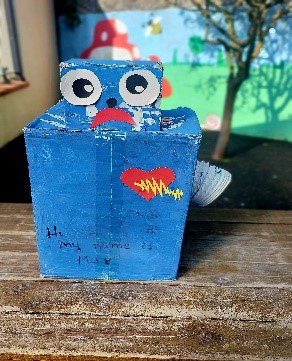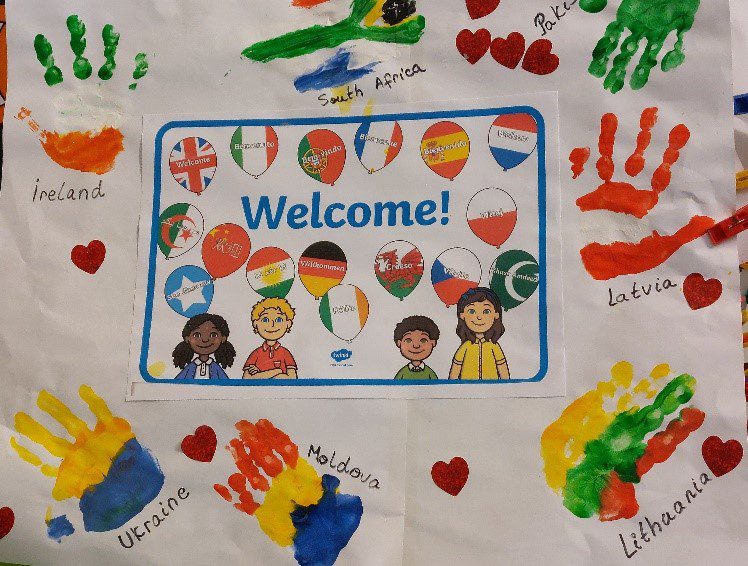The Power of Open-Ended Materials in Early Years:
Building Community Connections Through Sustainability
In this edition of the LINC Blog, LINC Graduate Laura Brady explores the magic of open-ended materials in early years education and how they connect us with sustainability and our communities. From simple joys like playing with cardboard boxes and stones to creating collaborative art with recycled items, discover how these materials spark creativity, foster learning, and promote environmental awareness

My first childhood memories are of being outdoors often, playing in the rain, running barefoot and spending time with friends. We created our own games as we played with things available to us, things found in the garden or around the house. On the contrary, nowadays a significant part of our daily lives revolves around electronics and devices.
Jackson Brown Jr.’s quote “Give children toys that are powered by their imagination, not by batteries.” —resonates with me.
Have you ever seen children having countless hours of fun with simple things like cardboard boxes, pots and pans, stones, and things found in nature?



Children learn a lot from exploring, creating, and sharing their ideas. Giving them the freedom to experiment and investigate is important as this kind of play ensures rich learning. Within our childcare facility, we are always working towards enhancing our learning environments and experiences for children. This year, our goal has been to introduce more real-life, open-ended materials while linking with families and the community around us. Our early years setting is community-based and has also benefited greatly from the addition of an adult education department that runs a variety of courses and hobby classes.
Sustainability matters:
Education for sustainable development is a key element of the Sustainable Development Goals target 4.7. This goal discusses that all learners should be empowered with the knowledge, skills, values and agency to make both informed decisions and to act responsibly to protect the environment (UNESCO 2024).
Open-ended materials can be any item that children can use in a range of ways. These can be natural objects, things from a child’s home or recycled items. Children will learn a lot about our environment, how they can use different materials in creative ways and that we can reuse things to create something unique instead of throwing them away.
Recently one of the preschool rooms gathered old CDs and the children had fun painting and decorating them. Collaborative art activities provide children with multiple benefits, such as teamwork, cooperation and self-expression.
Children of all ages enjoy playing with loose parts. With loose parts play the possibilities are endless! In addition to being a social activity, exploring various tactile materials like sand, water, paint, and beads may help children develop their language skills as they pick up new words to describe the textures of various materials and engage in discussions with their peers.
Practical Tips and Resources:
Children need guidance, time, and space to develop their play. What and how children play is influenced by the environment around them, therefore early childhood educators are crucial in setting up, arranging, and providing resources for the children (NCCA,2009). Linking in with our community members and families was an important part of our setting’s efforts to foster community relationships and include sustainability in the curriculum.
Examples of open-ended materials
- Pieces of bamboo
- Bark
- Old keys
- Plastic bottle tops
- Shells
- Cooking utensils
- Wooden blocks
- Jugs/ pots/saucepans
- Stones
- Pinecones
- Pasta etc.
Our goal was to develop a multicultural environment where children are recognised and can identify with the people around them. We have reached out to parents and community members by putting up posters on notice boards kindly asking for donations of items which would help us represent different countries and cultures, such as:
- Photos from home countries
- Wrappers of traditional foods
- Traditional dress up
- Storybooks
- Traditional cookbooks and utensils.
Parent Involvement Strategies:
Parents are the most valuable people in their children’s lives. They are the foundations of love, support, and direction. Parental involvement can provide us with important details about their children. Parents were welcome to visit their child’s classroom this year if they wished. Some have led an art activity, sung songs, and read stories in their home language. We even enjoyed gardening together.
The importance of community:
Community connections can give children a sense of belonging as they develop their social skills. As mentioned above our community members have donated various loose parts and open-ended materials for children to play with, explore and discover new possibilities. Items from home, brought in by the parents, help us represent the diverse lives and backgrounds of children who attend and are a good way of reusing materials.
Priority is to give the children in our care the best experiences possible. A strong and supportive community is one of the most important elements in high-quality practice, however, there are many other contributing factors. In our setting educators believe for children and families to feel welcome, secure and as they belong, we need to foster open communication, inclusiveness, respect, and shared resources and opportunities.
This year we have gone the extra mile to promote sustainability and limit waste. Students in our upcycling class received some unused furniture from our childcare department, and the results speak for themselves.



Data and Evidence:
Children are active learners, they learn about the world around them by interacting with the environment, according to Bruce (2005). Moreover, the Irish Early Years Curriculum framework, Aistear, views young children as capable and self-assured learners (NCCA, 2009). Theorists Piaget and Froebel also believed that children are active learners who learn about the world via open-ended activities and active interactions with their environment (Pound, 2004). The core of play-based learning in the classroom is direct exploration, and based on Piaget’s beliefs, this kind of active learning is best for children’s cognitive development.
In conclusion, every child deserves a happy childhood and quality education. No matter what country, culture, or background they are coming from, or what abilities they have, everyone should be accepted and respected and have the same opportunities. Close community links teach children to respect each other’s uniqueness, they become more understanding and accepting of the needs, feelings and ideas of others. Children thrive in safe, nurturing environments, where they can be themselves, build friendships and have exciting learning experiences. By embracing sustainable practices, children may build knowledge, investigate, and gain an understanding of the environment and how it relates to the rest of the world.
References list.
Bruce, T., (2005) ‘Ten Principles of the pioneers’, 3rd ed. London: Hodder Education
Fitzgerald, D. (2004) Parent Partnership in the Early Years, London: Continuum.
Jackson Brown, H (2009) The Complete Life’s Little Instruction Book. New York: Barnes & Noble.
National Council for Curriculum and Assessment (NCCA) (2009) Aistear, The Early Childhood Curriculum Framework: Principles and Themes, Dublin: NCCA
National Council for Curriculum and Assessment (NCCA), (2015) Aistear Siolta Practice Guide, available at: http://www.aistearsiolta.ie/en/ [Accessed 24 May 2024].
Pound, L., (2004) ‘How Children Learn – From Montessori to Vygotsky – Educational Theories and Approaches Made Easy, Practical Pre-School Books’, London: Step Forward Publishing.
UNESCO (2024) What you need to know about education for sustainable development, available at: https://www.unesco.org/en/sustainable-development/education/need-know [accessed 25 Nov 2024].

Laura Brady
LINC Graduate
Laura Brady, originally from Latvia, grew up with a strong appreciation for education and personal growth. In her twenties, she relocated to Ireland, where she worked tirelessly to build her career while nurturing her passion for learning. After nearly a decade, Laura returned to college and began her academic journey once again.
For the past five years, Laura has been working in an early-years setting in Ireland while continuing her studies. She recently completed her Level 7 degree at Portobello Institute and embraced the opportunity to step into the role of assistant manager in her setting, which opened up new learning experiences.
Motivated to deepen her expertise, Laura pursued the LINC Programme alongside earning a Level 8 BA (Hons) in Early Childhood Care and Education. She believes that as the early years sector continues to evolve, educators must remain open to new ideas and approaches to equip children with a strong foundation for future success.
